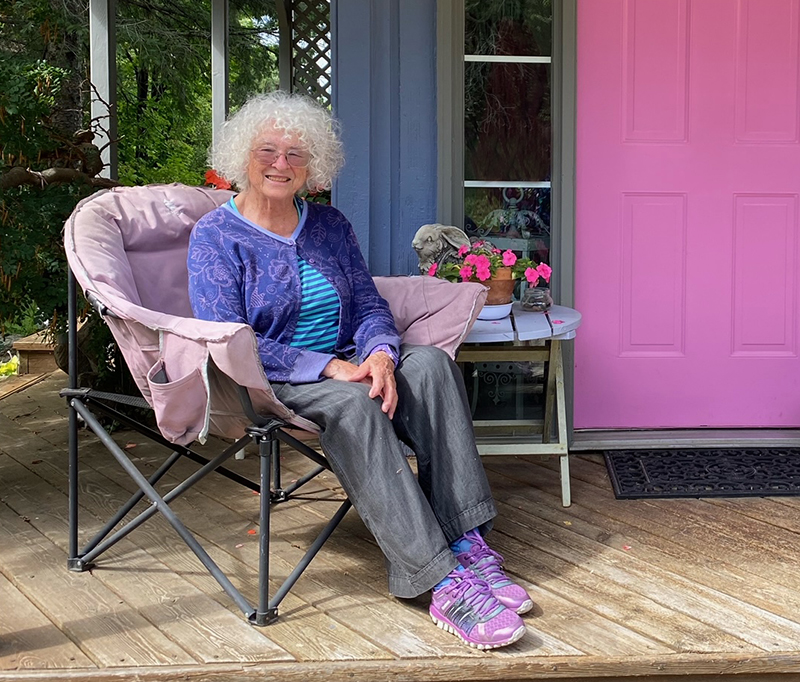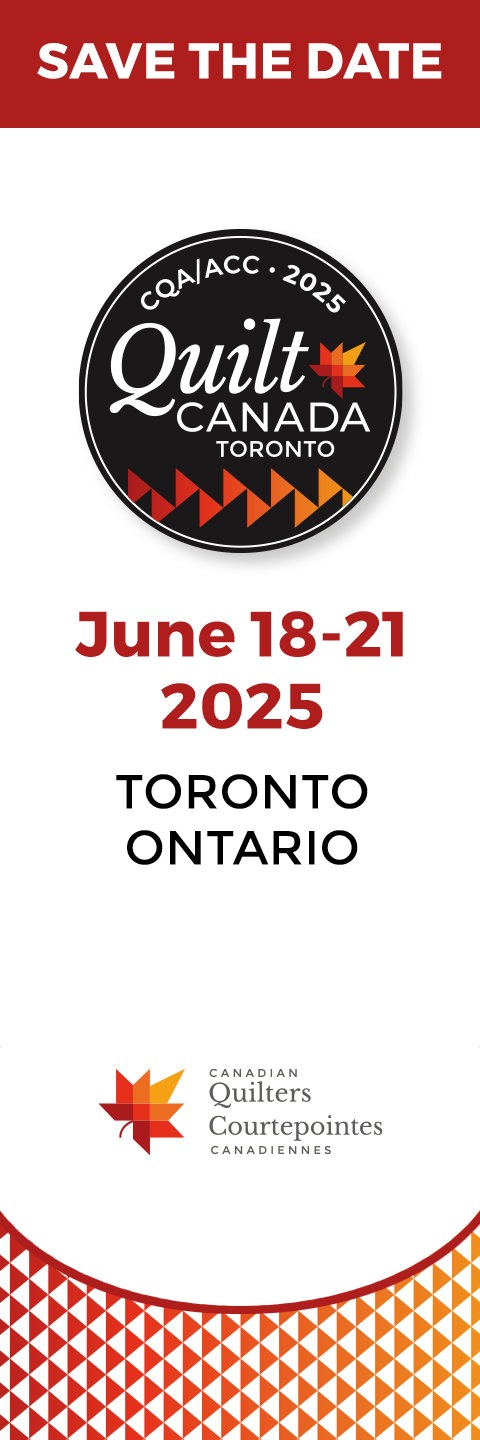PLEASE NOTE This article contains information about domestic violence and intimate partner violence, and may be triggering for some readers. Resources are available both locally and provincially. Contact your local shelter for counseling services and support, as well as protection when you need a safe place to stay. If you are in immediate danger, call 911.
AN INTRO TO QUILTING
Quilts have meant many things to many people over the years, but they are most commonly known as coverlets for beds, using what many of us think of as traditional quilt patterns. But, something happened in the early 1970s. Formally-trained artists and designers were attracted to the medium of cloth and quiltmaking. The design of quilts moved from traditional to non-traditional, or as some call it, art quilting. To me, all quilts are works of art in their own right, whether they were made before or after this change.
In 1975, I formed the second quilt guild in Canada, the Etobicoke Quilters Guild, with the enthusiastic help of my former quilt students from Humber College. And in 1977, I conceived of and co-convened the first Quilt Canada conference at York University in Toronto. While there are only two artists remaining of our guest lecturers now, it was a dream panel for me at the time: Jean Ray Laury of California, a graduate of design; Beth Gutcheon and her then husband Jeff Gutcheon, architect and musician; Virginia Avery of New York, a clothing designer and musician herself, who asked me if we had room in our budget for one more instructor; that was Michael James, then of Boston, an MA in Art; Kim Ondaatje, a Canadian art college graduate; and Mary Conroy from Sudbury.
What this conference did for me—aside from overstimulating me so much in Jean Ray Laury’s presence that I couldn’t produce a thing in her class—was to allow me to see quilts from a different perspective. I had been a traditional quiltmaker up to that point, but after seeing the work of those guest teachers, and the vastly different designs compared to traditional quilt design, I began to look at quilts as pictures in cloth. It made me realize that if I was ever to grow in my own design work, I needed further study in the visual arts.
At the time, it was a passing thought, a dream I felt would never come true, for how could I, a quiltmaker, qualify for art college? Until one day six years later, I did. At middle age, I was accepted as a part-time mature student at the Ontario College of Art (now OCAD University) in Toronto.
Following graduation, I confess that I had difficulty getting back into quilt making. I had been exposed to centuries of beautiful and innovative artworks; my own quilt work suffered in comparison. Finally, after a year, I stopped comparing my work to that of the great artists I’d learned about in college, and made my way back into quilting.
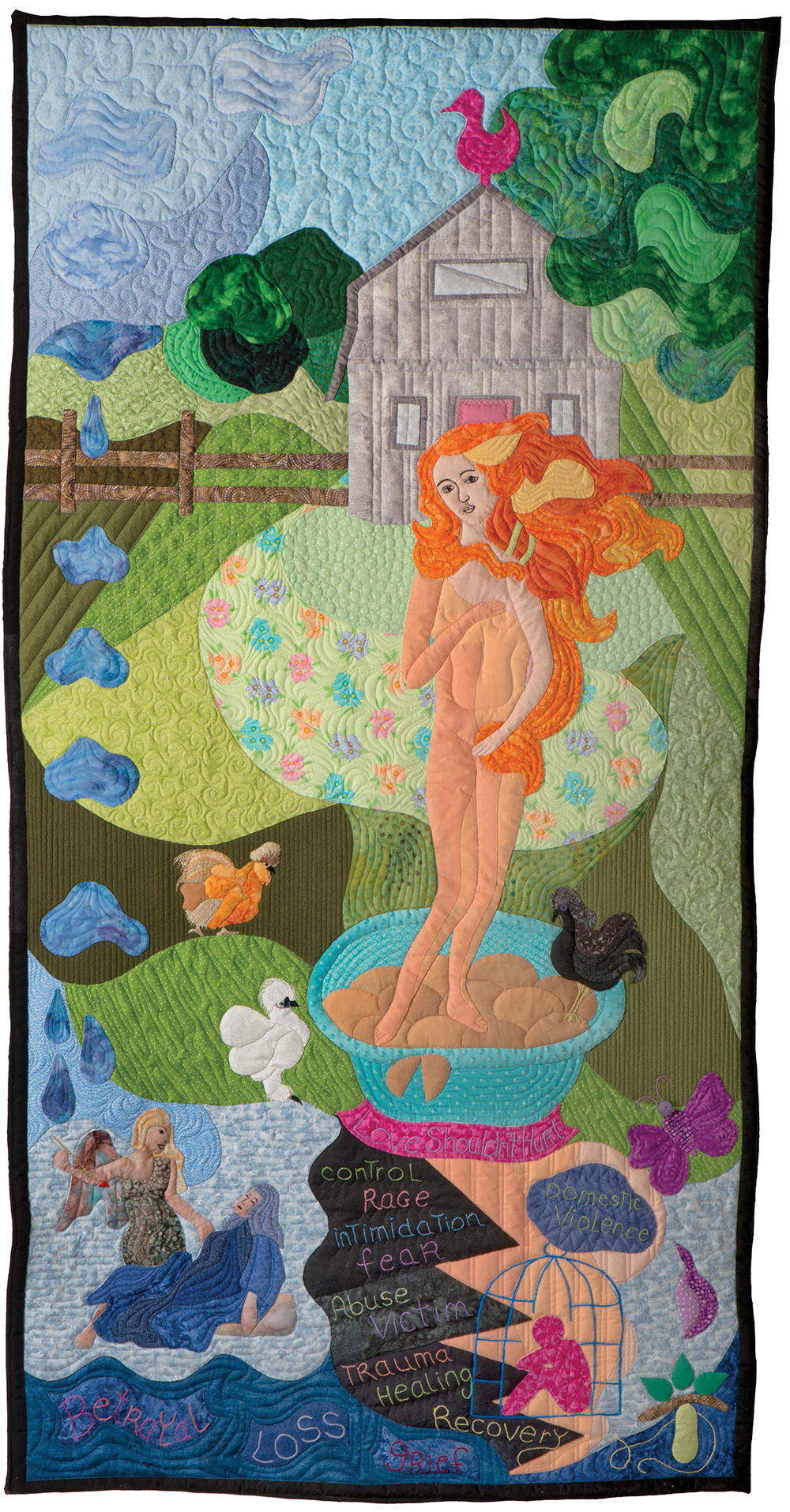
Coercive Control—Click for Artist Statement
by Sandra Small Proudfoot, Mono, ON, 2022
Machine Quilting by Mary Light, Temiskaming Shores, ON
Photo by Pete Paterson, Caledon, ON
ARTIST STATEMENT
Coercive Control is a term used in intimate partner relationships where abusive behaviours lead to domestic violence. From my experience, I hope to put a visual face to this tragic issue. The design portrays a loving relationship, peaceful meadows, sky above and trees surround, and Botticelli’s Birth of Venus standing before my chicken house in the country. When that relationship breaks down and becomes abusive, we are vulnerable; our ‘emotional’ eggs have been placed in our loved one’s basket. Clouds gather and darken as they fall through a formerly loving relationship onto Bernini’s sculpture The Ecstasy of Santa Teresa. A winged angel, his spear filled with divine love, is thrust into the heart of the nun lying beneath him. Yet, to me, this sculpture also speaks of betrayal. The angel’s duplicitous smile and his sharpened spear remind me of domestic violence, and the heartbreak associated with it. Domestic violence places victims in a cage of emotional, financial, and often physical abuse; fearfully exposed to another’s anger and control. Shelter is needed. But then, one day on a leafy branch, a tiny green chrysalis appears. From this, a beautiful new butterfly is born. Recovery is possible. A new life begins.
MY CURRENT WORK
Today, I am focusing a lot of my design work on what I call ‘statement’ quilts…quilts that tell a story. And, this is really what this article is all about. My latest work, a trilogy on intimate partner violence, is centred around a very serious issue in society today.
Intimate partner violence, or domestic violence, knows no age or socioeconomic barriers; no ethnic, religious, cultural, or educational boundaries. Women’s shelters are overflowing with victims of abuse of all ages, from babies to the elderly. At my local women’s shelter, Family Transition Place in Orangeville, ON, there is seldom an empty bed.
Having experienced it myself, I am drawn to using my quilt work to raise awareness of domestic violence, which has reached epidemic proportions and has been declared as such by many cities, towns, and communities in Canada.
I felt that if I could put a visual ‘face’ to domestic violence, it would bring a greater awareness to the general public with regard to the victims’ experiences and their feelings.
The trilogy began with the design of Coercive Control. Some of the inspiration for this quilt came when I was taking an online Art History course from the University of Guelph during the pandemic. I’ve long admired Bottecelli’s Birth of Venus. To me, she represents a beautiful but vulnerable woman.
I was introduced to Bernini’s magnificent sculptures, but my interpretation of Santa Teresa was different to that of the art historians, in that it spoke to me of betrayal. Why was the male angel holding a sharp spear pointed towards the woman lying at his feet, passed out? (Art historians say she is swooning being so close to God.) I chose this sculpture to depict betrayal. There is a little chrysalis in the bottom right-hand corner, with a beautiful butterfly emerging. The caged woman is released.
To be able to take something so destructive and harmful, and turn it into a catalyst for creativity, change, and support, is a privilege that quilting has allowed me.
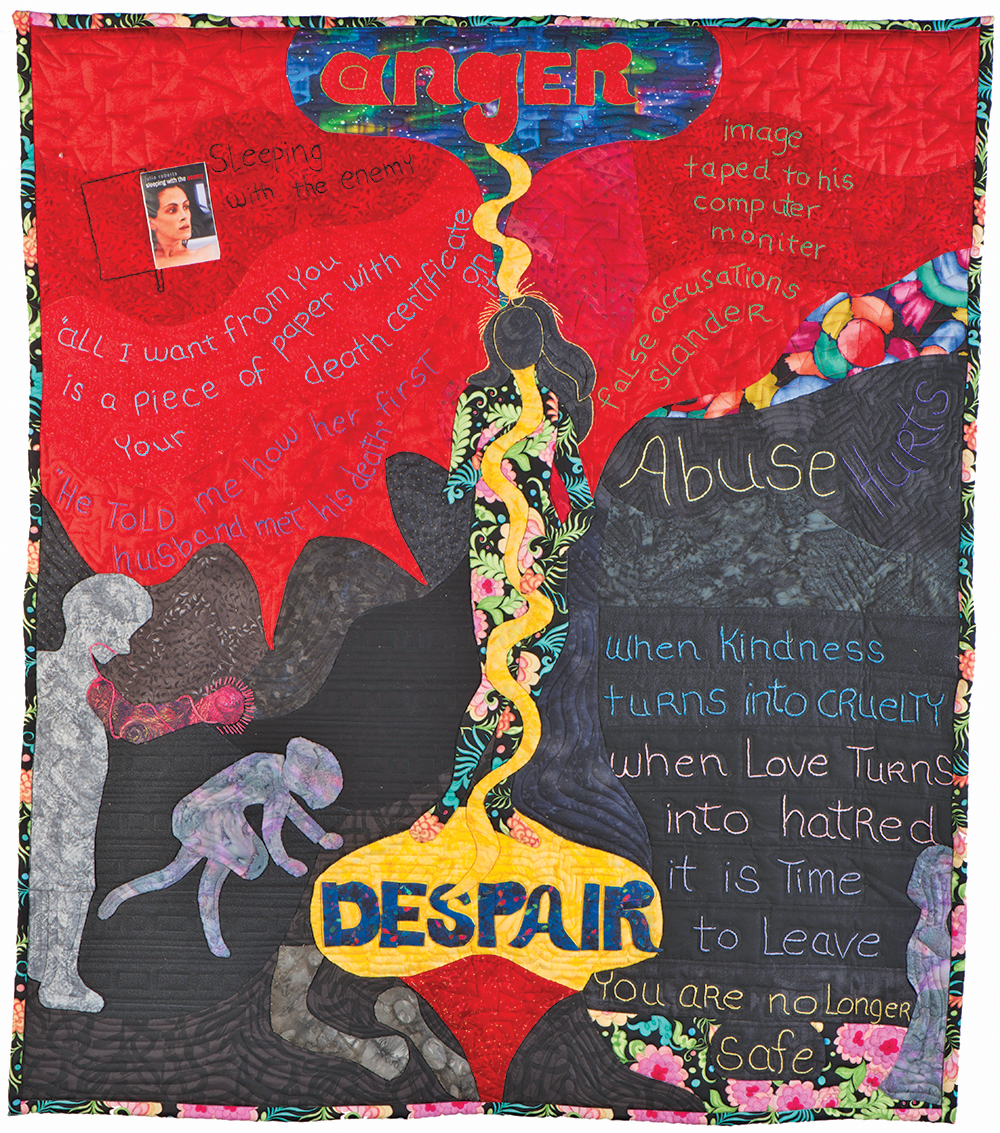
The Closed Fist: Addressing physical and emotional abuse—Click for Artist Statement
by Sandra Small Proudfoot, 2023
Machine Quilting by Mary Light
Photo by Pete Paterson
Photo Transfer by Dee Blaides
ARTIST STATEMENT
This is not so much an artist’s statement, as an explanation of my design process while creating this textile piece. If you have never experienced domestic violence yourself, I hope that what you see will bring some awareness of this tragic issue. If you have experienced domestic violence, I hope you will find some meaning in this piece.
Abuse has many faces: physical abuse, emotional abuse, financial abuse, sexual abuse, elder abuse. Each person’s experience is individual. Given my own experience, and working in textiles as I have done for over 60 years, I tried to bring a visual awareness to the traumatic issue of gender-based violence, usually perpetrated by men against women. When I created the first quilt in this series, Coercive Control, it was to bring a focus to this form of abuse. (Bill C-332, currently before the Canadian Parliament, seeks to criminalize coercive control when it has significant impact on the victim.) I then created The Porch: Opening the Door to Recovery to show what that could look like visually. But, I was always aware that there was one piece missing in between those two works, and that involved visually addressing the abuse itself. But, how does one interpret abuse in a visual sense without offending the viewer?
As I was trained to do in art college, I set about to write my POV (Point of View) on what I hoped to say visually in this piece. I chose as my subjects the physical and emotional aspects of abuse, as I felt they could be demonstrated. I planned to use Botticelli’s Venus again as my focal point of a woman abused, because to me she represents a beautiful but vulnerable woman. In writing my POV I asked myself what lies behind abuse. To me, the answer is anger, anger along with all that lies behind the reason for anger. And, I also knew that unless I put myself into this piece, personally, the feelings I was hoping to convey would not be there.
I began to lay out my fabrics as painters do their paints. I purposely chose fabrics that spoke to me visually about the subject of abuse. The colour red, to me, represents anger. Black I chose to represent the grief and despair felt by victims of abuse. For Venus, I chose a very attractive print with a black background, combining, I felt, the beauty of who my Venus is as a woman and the black background reflecting the pain and suffering she experiences in an abusive relationship. For the perpetrator of the abuse, I chose a ghostly grey print that reminded me of the harshness and visual weight of cement, and I deliberately chose a contrasting colour for the perpetrator’s arm and fist, to bring attention to the means by which many women are assaulted. For the woman being assaulted, I chose a soft and delicate fabric. Abuse, visually, is not something one might wish to see on a wall quilt; it is not pretty at all. As for the mental abuse, I decided that words were the only way to enable the viewer to have an understanding of it. Carefully embroidered, I chose three comments made to and about me, in relation to the abuse I experienced, which were intentionally hurtful towards me. I placed these comments on the red of anger with a brief explanation embroidered opposite the comments. And so the design developed.
With my Venus, I tried to describe visually what it feels like to be suddenly attacked and assaulted by someone, especially an intimate partner. It’s like a bolt of lightning running through your body, thus, Venus has a bolt of lightning coursing through her body, falling into a pool of despair below. By then, any thought of design principles that I would normally use departed, and I visually spoke of my frustration with a small piece of cloth of multiple shapes and colours, completely different from the other fabrics, and placed it on the upper right side of my work.
Then I had to walk away from it. It was stirring up too many painful memories and emotions in me. The design felt disturbing to me. One night, a week or so later, I was awakened in the middle of the night with words clearly speaking to me in my mind. They were: “When kindness turns into cruelty, when love turns into hatred, it is time to leave; you are no longer safe.” I returned to my work the following morning and finished the piece. Colours, shapes, words that I hope will allow the viewer to have a sense of what abuse feels like.
I asked Mary Light, who machine quilts my work, how she felt about it. Here is what she said:
When I read Sandy’s artist statement, I was deeply saddened and longing for justice for her. As I began quilting this piece, I knew that all of the text needed to be emphasized. The feeling of anger portrayed by the red fabric needed sharp and jerky quilting lines—I felt frustration that words can wound so deeply. To me, the black, curved lines under the red fabric, around ‘Abuse Hurts,’ and over and under ‘Despair,’ show how these wounds from words can weigh one down, making it hard to move forward. The dots and dashes around the victim struck down are representative of messaging SOS (a plea for help) from earlier times. One of the last areas I quilted was the image of the perpetrator. I was angry and the quilting reflects that; more of a scribble than carefully completed. I didn’t want anything ‘nice’ in that quilting. This quilt carries an important message that we need to hear. When love turns into hatred—it is time to leave.
Next, I concentrated on creating a design around recovery and hope, called The Porch: Opening the Door to Recovery. Though this quilt is the third in the trilogy, I made it second; I was trying to avoid making The Closed Fist: Addressing physical and emotional abuse, as I found it emotionally too difficult to create.
With The Porch, I wanted to bring hope to victims of abuse who are in recovery. I reached to Christi Belcourt’s wonderful paintings for inspiration, for my flowers cascading down upon the door, andwomen below.
It was made in the spring of 2023, when the flowers were blooming. My dogs, the wild rabbit who lives under my frontporch in winter, the birds, and my friend, are all part of my own recovery. The Porch is my porch, the front door displayed is my front door. Creating this quilt was my happy time.
Still, I knew there was one more statement to be made, and that involved addressing the abuse itself. The Closed Fist: Addressing physical and emotional abuse, became the middle quilt in the trilogy. This was not an easy piece to make, so I’ll leave my artist’s statement to explain the process of design. It’s rather long, but it is meaningful for me.
To be able to take something so destructive and harmful, and turn it into a catalyst for creativity, change, and support, is a privilege that quilting has allowed me.
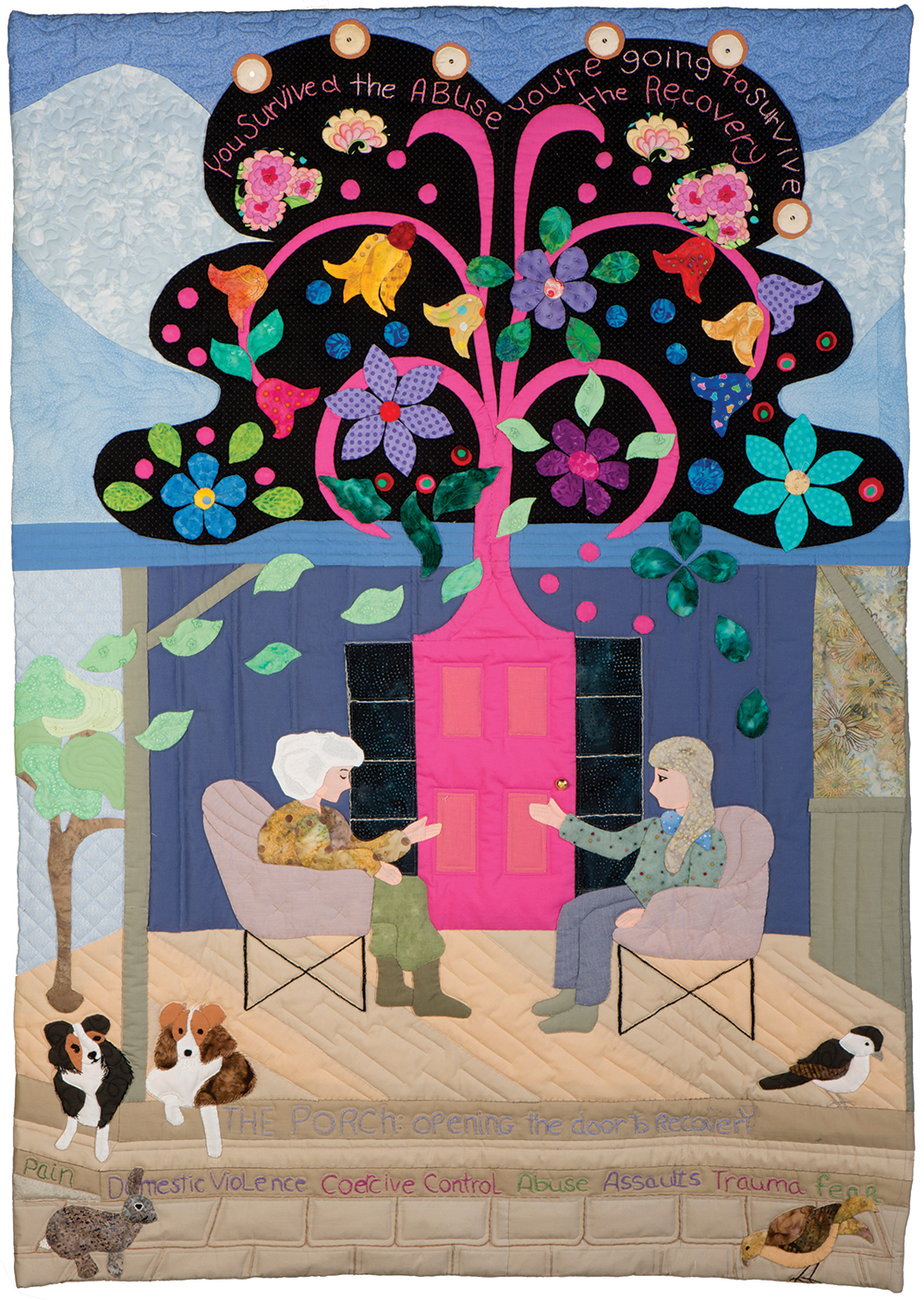
The Porch: Opening the Door to Recovery—Click for Artist Statement
The Porch: Opening the Door to Recovery
by Sandra Small Proudfoot, 2023
Machine Quilting by Mary Light
Photo by Pete Paterson
ARTIST STATEMENT
Recovery from domestic violence, which is also referred to as intimate partner violence, can be a very difficult process. Often years of emotional, physical, and almost certainly financial abuse, leaves victims traumatized beyond the comprehension of those who have not experienced it. There is no timeline for the grief involved, and if the court system is involved, it can be a discouraging revictimization of the abused, usually women.
The Porch is about hope, renewal, and opening the door to recovery through counselling, through connecting with others who have experienced abuse, through women’s shelters which can provide a safe haven from an abusive relationship threatening the safety of women and children. Upon the porch sit two chairs, one for the abused, one for those who offer support and help guide us through this process. Reaching out for help, we can open the doorway to recovery. The black clouds of grief, of loneliness, of fear, and of pain gather above and lie heavily upon the victims of domestic violence, as they wonder what lies ahead. Yet, within that grief lies hope for survival. An explosion of brightly coloured flowers, inspired by the artwork of Métis artist Christi Belcourt, represent the hope of a better future. Spilling out of those dark clouds, the door opens. If we survived the abuse, we will survive the recovery. But, we will never forget.
My dogs, rabbits, birds, my special friends, the support from my local women’s shelter, the peace of nature around me, all contribute to my ongoing recovery.
QUILTS MAKE A DIFFERENCE
Quilts mean a lot of different things to different people. They speak of love, they speak of warm and cozy feelings, they speak of caring.
Many community quilt guilds donate quilts to charities and hospitals and are not fully recognized for the wonderful work they do in their communities.
My local guild, Dufferin Piecemakers, supported Family Transition Place when I donated a quilt in January 2023, to help raise money for the victims coming into the shelter. Another quilt is going to be raffled off in 2024 for this same purpose.
The funds raised last year helped to purchase cell phones for victims, and pay for mobile plans. Basic necessities, such as diapers for babies and the elderly victims, and sleepware, were also purchased, as victims often arrive at shelters with very few personal belongings. Supporting victims of domestic violence through the donation of raffle quilts is something I hope to inspire other guilds to consider doing, for this is a very serious problem
in every community today.
Quilts make a difference in people’s lives, sometimes in unexpected ways.

